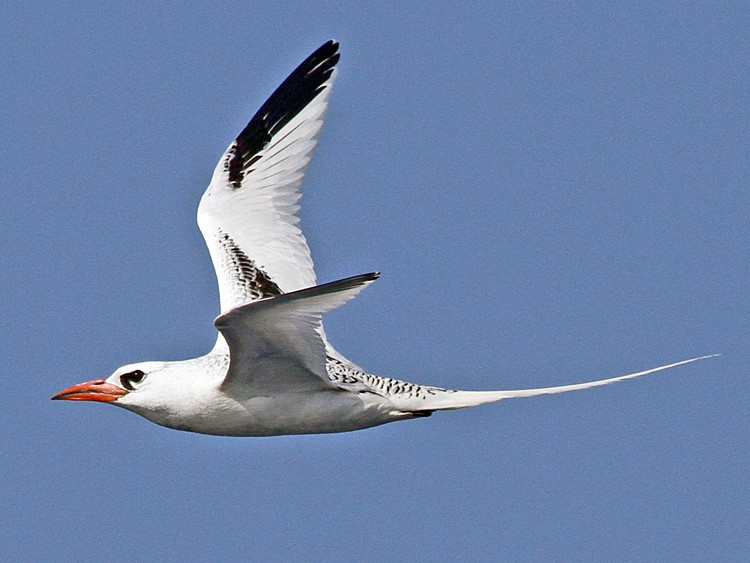Birdfinding.info ⇒ Locally common along the southern coast of Oman, where it can often be seen at Raysut and Wadi Hanna, and on offshore trips out of Mirbat. It can also be found at breeding sites on small islands between Qatar and Abu Dhabi, and at Perumal Par in the Lakshadweep Archipelago west of Kerala, India.
Arabian Tropicbird
Phaethon indicus
Northwestern Indian Ocean and adjacent seas.
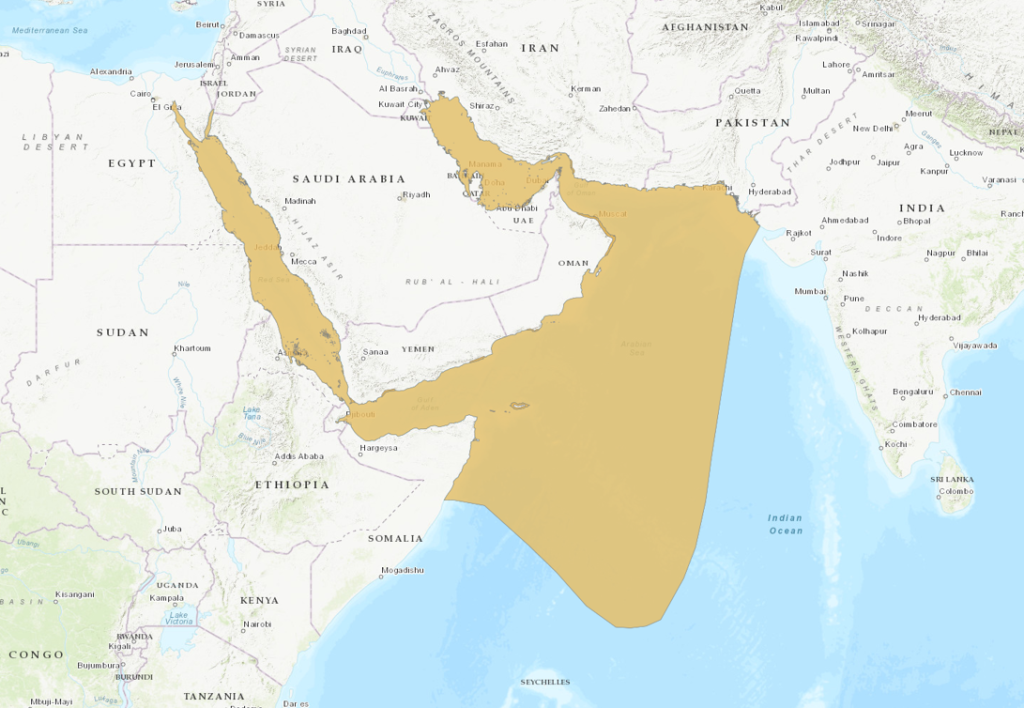
Approximate range of the Arabian Tropicbird. © BirdLife International 2019
Breeding. Islets in the southern Red Sea, the Gulfs of Aden and Oman, the southern Persian Gulf, Socotra Island, and the Lakshadweep Archipelago of Kerala, India.
Qarnein Island (Abu Dhabi) appears to support an especially significant nesting colony, with up to 100 pairs reported.
Nonbreeding. Disperses throughout the waters around its breeding areas, including the full lengths of the Red Sea and Persian Gulf. The extent of its regular occurrence in the Indian Ocean is not well understood, but it apparently occurs regularly to Sri Lanka, and there are at least a few records from the Bay of Bengal, and one (photographed) from Ashmore Reef in the Timor Sea.
Identification
The shortest-tailed tropicbird. Unlike other tropicbirds, its tail streamers rarely if ever equal the length of the body.
Adult’s bill varies from pinkish-orange to coral-red, depending on breeding condition, and blackish edges (on the tip, the nostril groove, and the “lips”).
Adult plumage is white overall with black markings on the upperparts. At a distance it appears mostly white with two bold bars on each wing.
Viewed more closely, it is boldly barred and scalloped from the nape to the rump, and on the wing coverts—becoming a distinct, pronounced bar on the secondary coverts. The other bar covers the outer primaries and adjacent coverts.

Arabian Tropicbird, showing coral-red bill. (Perumal Par, Lakshadweep, India; January 13, 2015.) © Bijoy Kombarakkaran
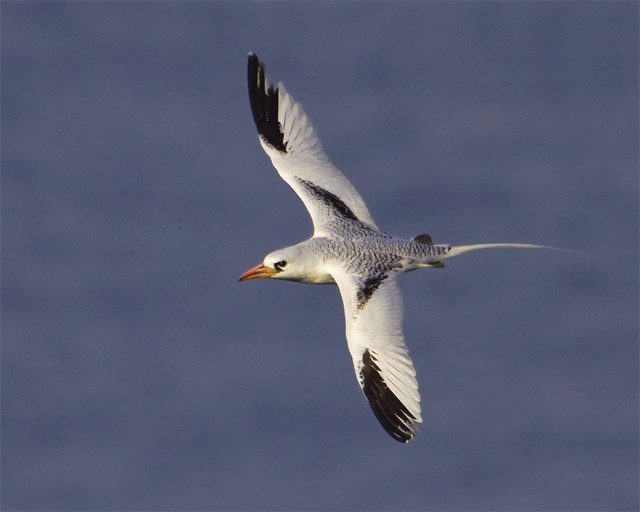
Arabian Tropicbird. (Halulu Island Qatar; October 16, 2010.) © Gavin Farnell
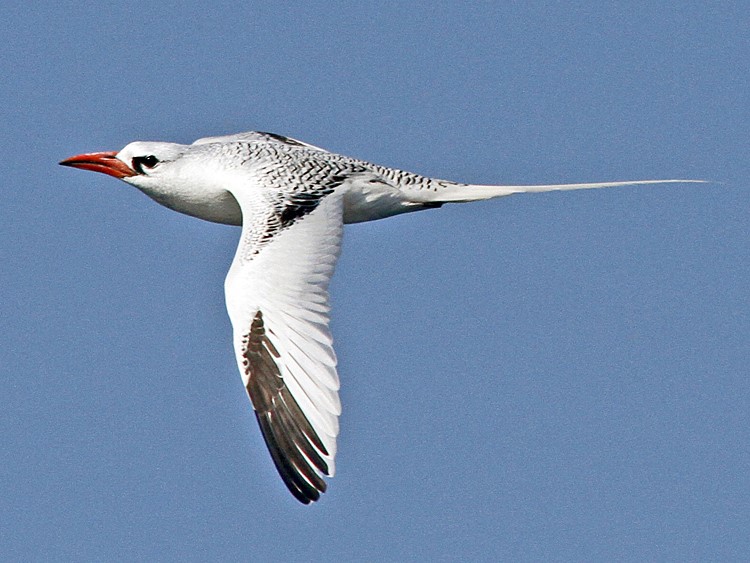
Arabian Tropicbird, showing coral-red bill. (Al Fahl Island, Dhofar, Oman; November 4, 2017.) © Rob Lee
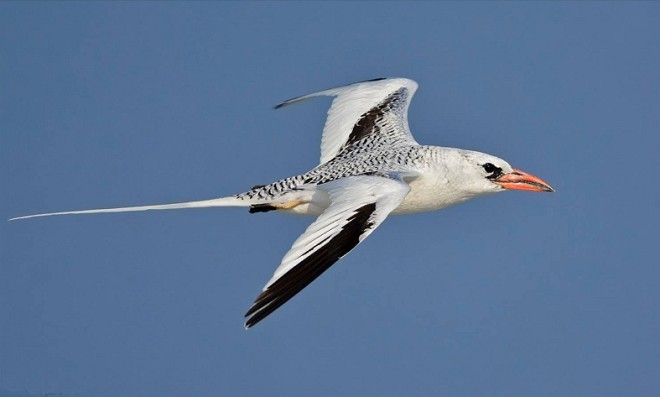
Arabian Tropicbird, showing pinkish-orange bill. (Perumal Par, Lakshadweep, India; January 13, 2015.) © Bijoy Kombarakkaran
Adult Arabian’s head is mostly white with a crescent-shaped, black “teardrop” marking. Subadults and some (perhaps young) adults show a subtle eyestripe that extends back from the eye to the hindcrown and wraps around to form a partial collar.
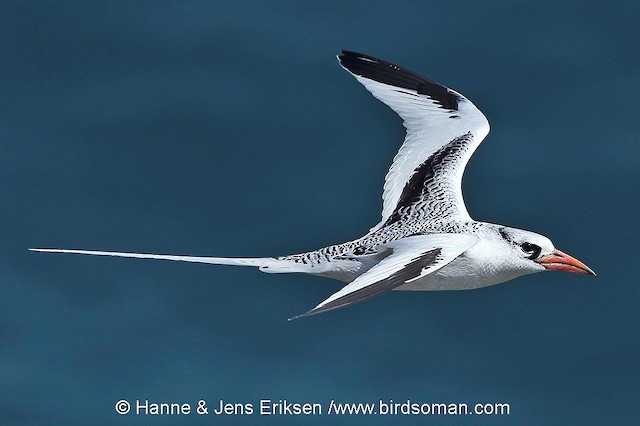
Arabian Tropicbird, perhaps a younger adult as it has partial eyelines that join to form a thin black collar. (Wadi Hanna, Dhofar, Oman; April 28, 2015.) © Jens Eriksen

Arabian Tropicbird, perhaps a younger adult as it has partial eyelines that join to form a thin black collar. (Wadi Hanna, Dhofar, Oman; April 28, 2015.) © Jens Eriksen
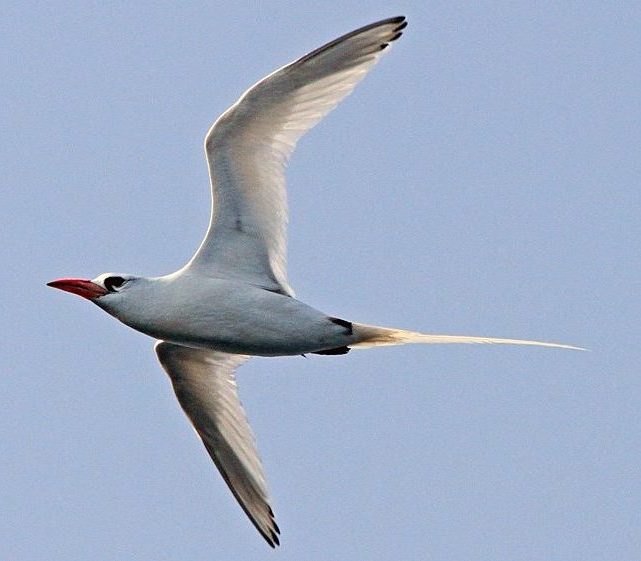
Arabian Tropicbird, showing translucence of wings and black tips on the undersides of the primaries. (Al Fahl Island, Dhofar, Oman; November 4, 2017.) © Rob Lee
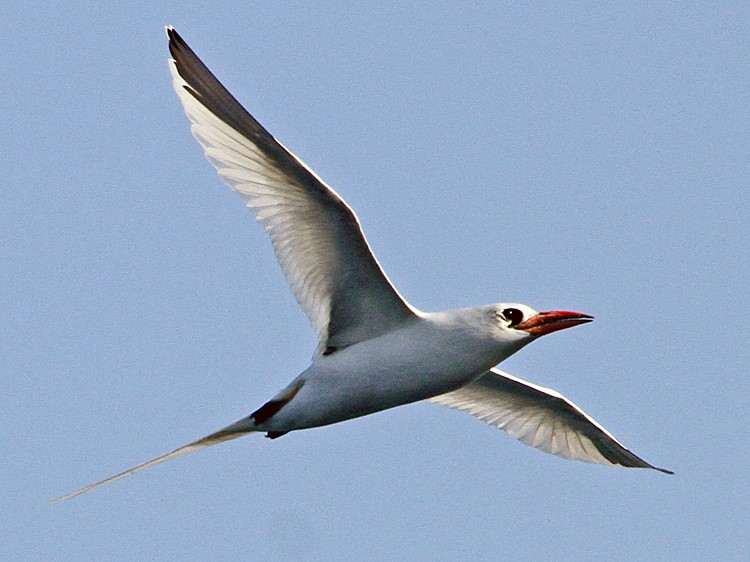
Arabian Tropicbird, showing translucence of wings and mostly white face. (Al Fahl Island, Dhofar, Oman; November 4, 2017.) © Rob Lee
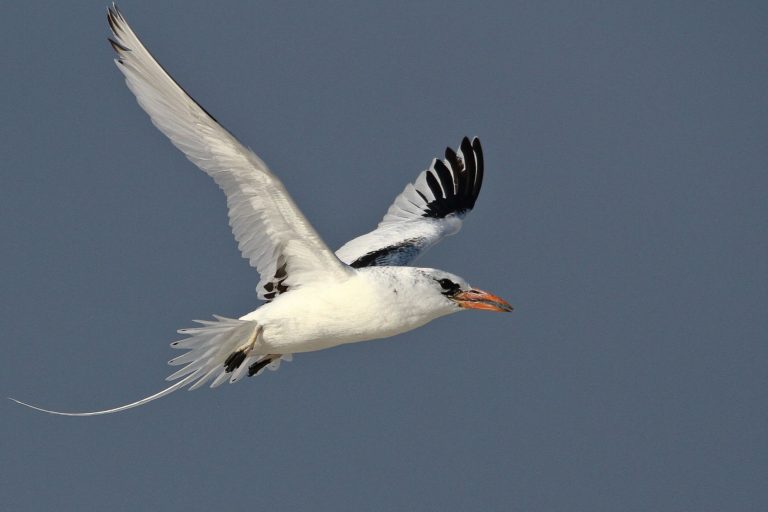
Arabian Tropicbird. (Lakshadweep, India; January 13, 2015.) © Jomy Varghese

Arabian Tropicbird. (Perumal Par, Lakshadweep, India; January 13, 2015.) © Bijoy Kombarakkaran

Arabian Tropicbird. (Perumal Par, Lakshadweep, India; January 13, 2015.) © Bijoy Kombarakkaran

Arabian Tropicbird. (Perumal Par, Lakshadweep, India; January 13, 2015.) © Bijoy Kombarakkaran
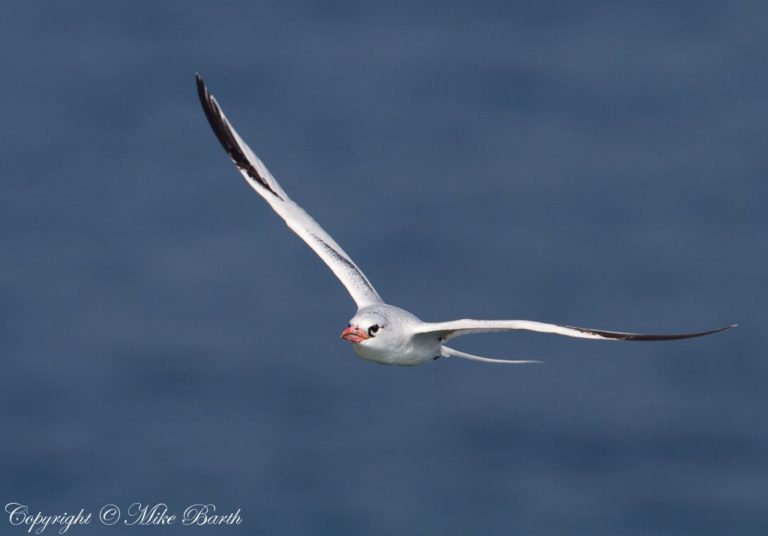
Arabian Tropicbird. (Qarnein Island, Abu Dhabi; 2012.) © Mike Barth

Arabian Tropicbird, in profile, showing black leading edges of primaries. (Perumal Par, Lakshadweep, India; January 13, 2015.) © Bijoy Kombarakkaran
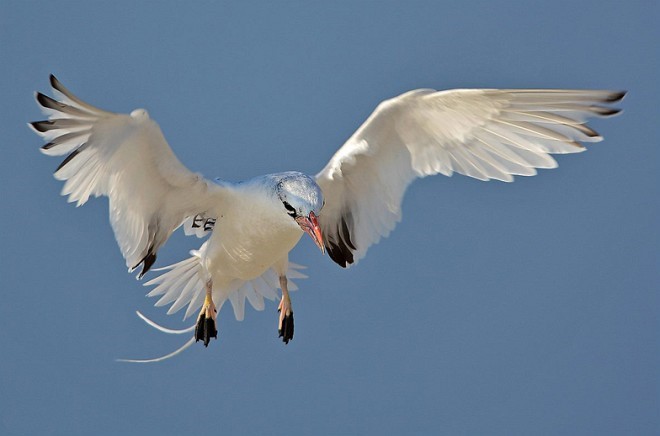
Arabian Tropicbird, showing black tips on the undersides of outer primaries and inner secondaries. (Perumal Par, Lakshadweep, India; January 13, 2015.) © Bijoy Kombarakkaran

Arabian Tropicbird, showing bicolored legs and feet. (Perumal Par, Lakshadweep, India; January 13, 2015.) © Bijoy Kombarakkaran
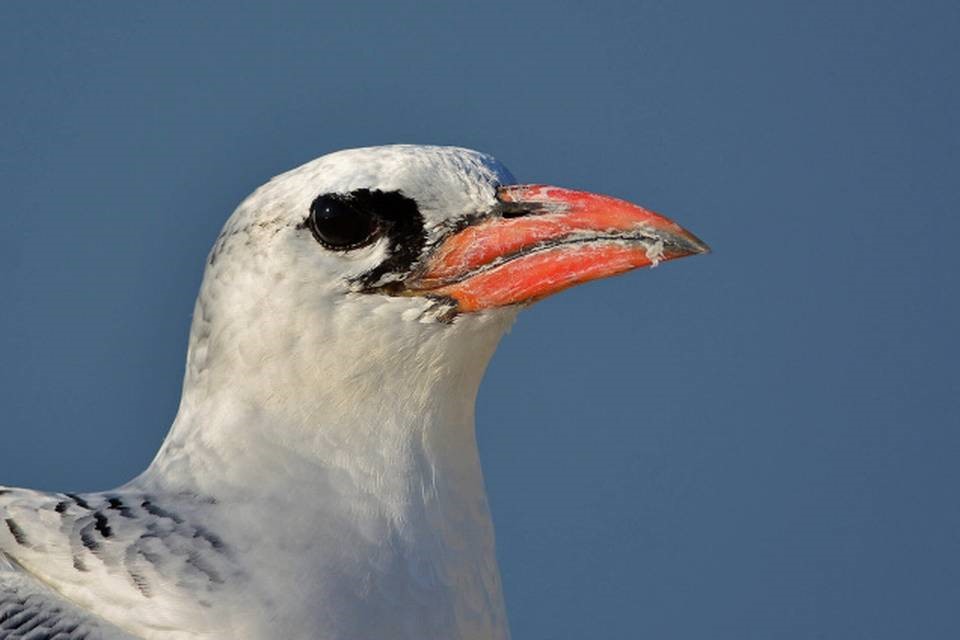
Arabian Tropicbird, close view of bill showing blackish edges. (Perumal Par, Lakshadweep, India; January 13, 2015.) © Bijoy Kombarakkaran
Immature Plumages. Juvenile is similar overall to those of other tropicbirds: white and finely barred with black from the nape back to the rump and across the wing covets. Like the adult, the barring is densest on the wing coverts, where it forms a distinct carpal bar.
Also like the adult, its five outer primaries are mostly black, as are the adjacent primary coverts, forming a black bar on the outer wing.
Unlike the adult, immatures have a pronounced eyestripe that extends back from the eye to the hindcrown and wraps around the nape to form a partial collar.
The immature’s bill is horn-colored (sometimes slightly pinkish) with blackish edges. The bill progressively flushes pinker, then rosy-orange, and always retains the blackish edges.
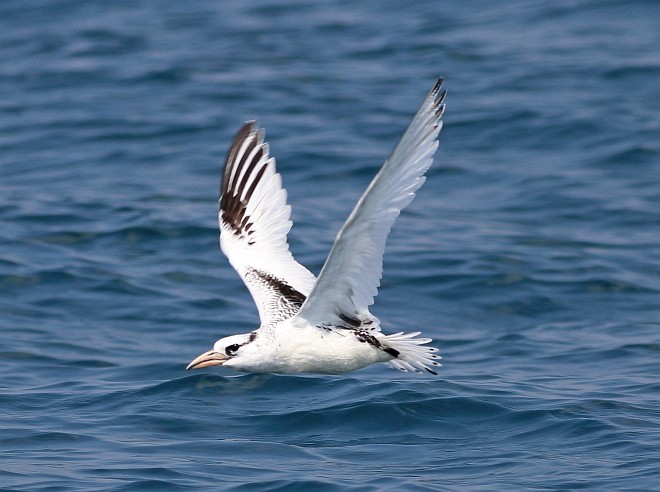
Arabian Tropicbird, immature showing thick, horn-colored, black-edged bill, strong carpal bar, and eyelines that join to form a thin black collar. (Offshore from Vasco da Gama, South Goa, India; November 5, 2017.) © Manjusha Savant
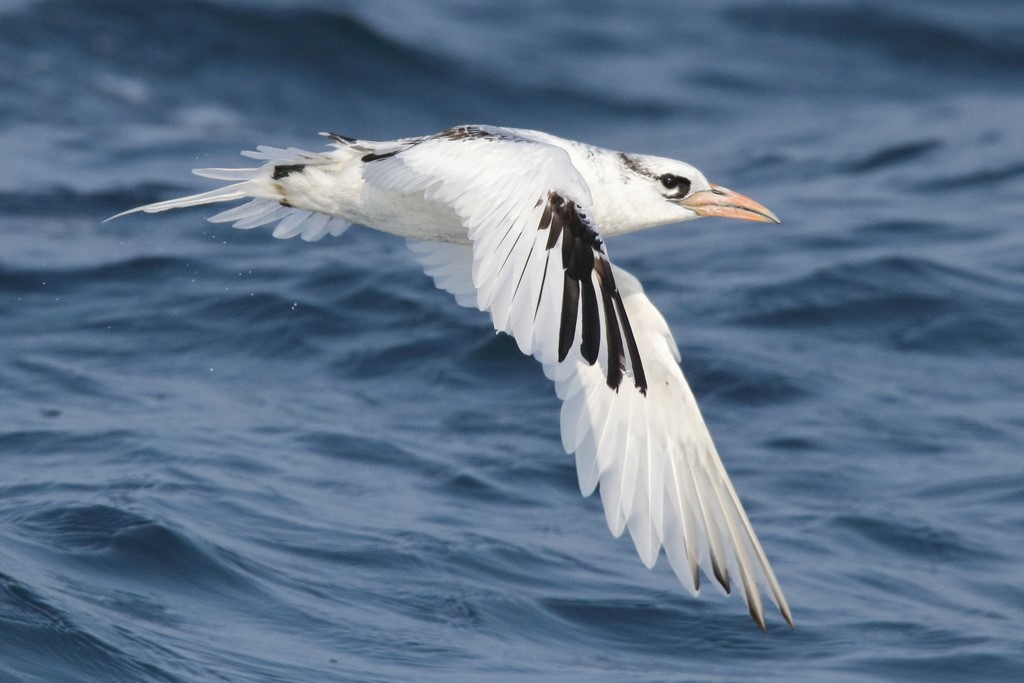
Arabian Tropicbird, subadult showing partial eyelines that join to form a thin black collar. (Dakshina Kannada, Karnataka, India; December 30, 2017.) © Harshith JV
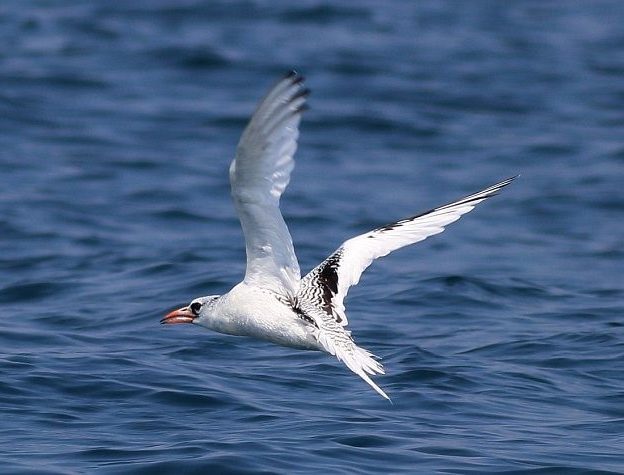
Arabian Tropicbird, subadult—note single tail streamer beginning to extend. (Offshore from Vasco da Gama, South Goa, India; November 5, 2017.) © Manjusha Savant
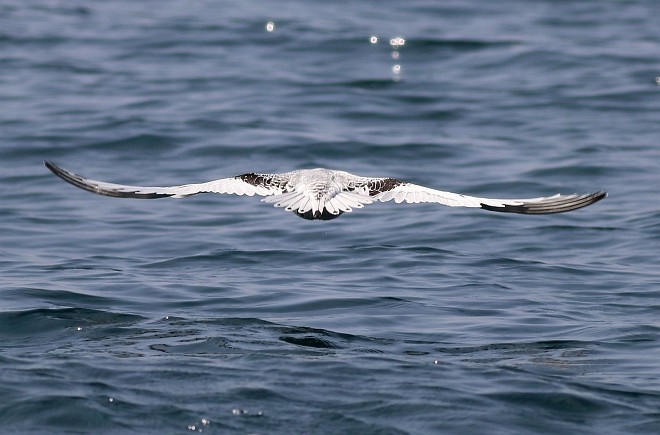
Arabian Tropicbird, immature in low departing flight, showing upperparts pattern. (Offshore from Vasco da Gama, South Goa, India; November 5, 2017.) © Manjusha Savant
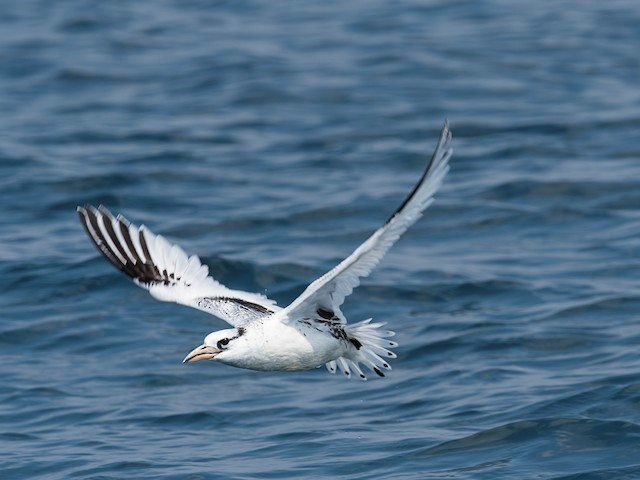
Arabian Tropicbird, immature—note single spot near the tip of each tail feather. (Offshore from Goa, India; November 5, 2017.) © Harish Thangaraj
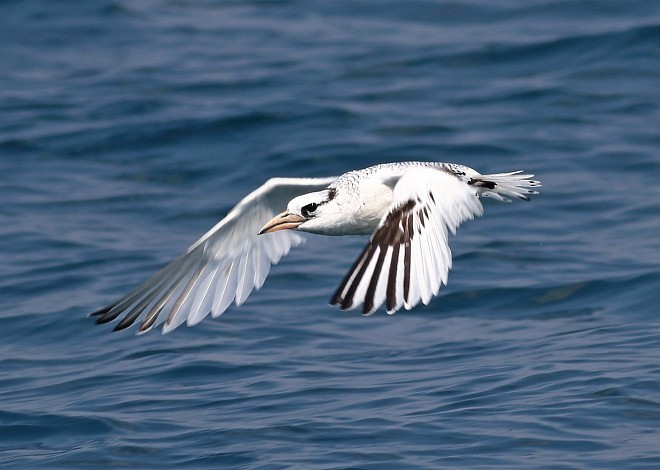
Arabian Tropicbird, immature with primaries fully fanned and showing black outer webs on the first five. (Offshore from Vasco da Gama, South Goa, India; November 5, 2017.) © Manjusha Savant

Arabian Tropicbird, immature. (Offshore from Goa, India; November 5, 2017.) © Pronoy Baidya
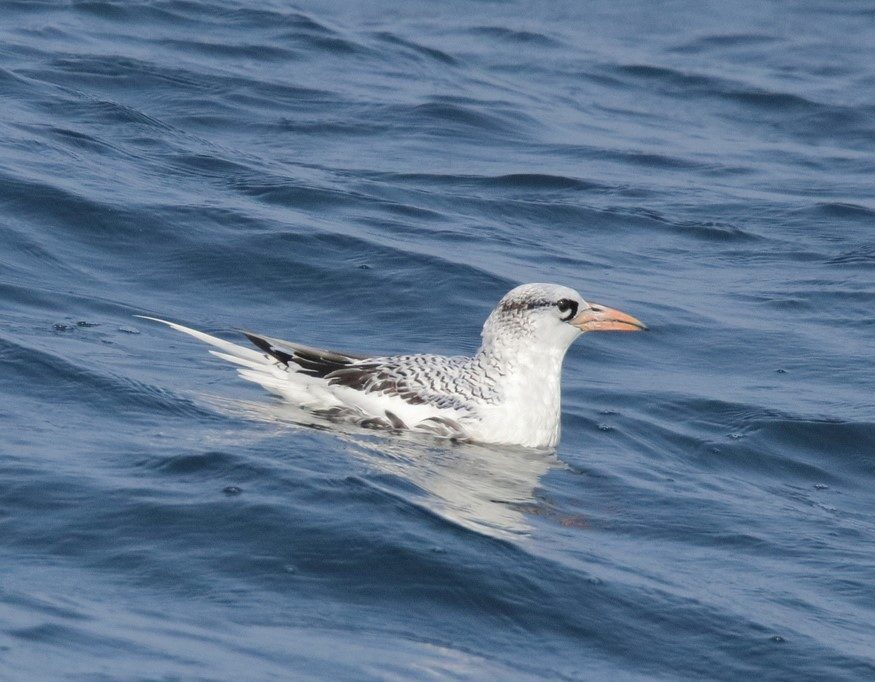
Arabian Tropicbird, subadult—note tail streamer beginning to extend. (Dakshina Kannada, Karnataka, India; December 30, 2017.) © Harshith JV
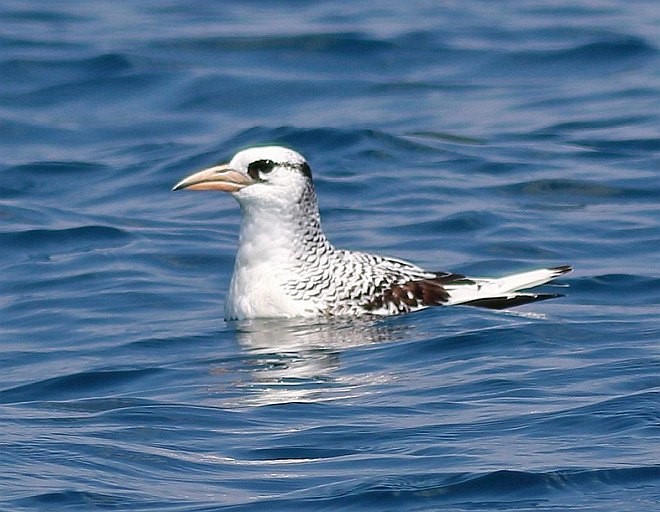
Arabian Tropicbird, immature. (Offshore from Vasco da Gama, South Goa, India; November 5, 2017.) © Manjusha Savant
Cf. Red-billed Tropicbird. Red-billed and Arabian Tropicbirds are similar species that do not regularly come into contact with one another and would rarely be mistaken for one another on geographical grounds. However, some vagrants may cause confusion, as both have been photographed in Australia. The distinctions are also relevant to the question of taxonomic status.
Adult Red-billed and Arabian Tropicbirds differ in three distinctive features:
Tail: Arabian’s tail streamers rarely approach the length of the body, whereas Red-billed’s regularly grow much longer. Red-billed’s streamers are not always long, so short streamers do not rule out Red-billed, but long streamers confirm Red-billed.

Red-billed Tropicbird, showing longish tail streamers, bold, black eyestripe, thin, all-red bill, and fine barring on the back. (Little Tobago Island, Trinidad & Tobago; January 13, 2020.) © Steven Hunter

Arabian Tropicbird, showing typically short tail streamers, crescent teardrop marking, thick, black-edged bill, and relatively coarse barring on the back. (Perumal Par, Lakshadweep, India; January 13, 2015.) © Bijoy Kombarakkaran
Facial Markings: Adult Red-billed has a bold black eyestripe that extends from the eye to the hindcrown. Fully mature Arabian has no eyestripe, but instead has a crescent-shaped black “teardrop” marking. However, subadult and some apparently adult (but presumably young adult) Arabians retain an indistinct blackish eyetripe—somewhat resembling Red-billed’s eyestripe, but lacking its boldness and crisp contrast.
Bill: Arabian’s bill is proportionately shorter and thicker, and it has blackish edges whereas Red-billed’s is all-red.
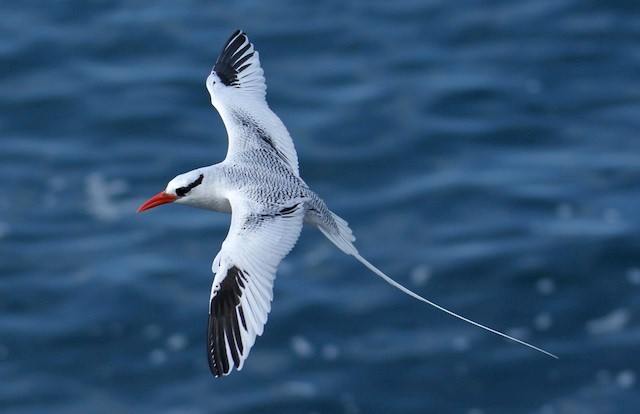
Red-billed Tropicbird, showing longish tail streamers, bold, black eyestripe, thin, all-red bill, and subtle carpal bars. (Isla Santa Fé, Galápagos, Ecuador; March 24, 2011.) © Jeremiah Trimble

Arabian Tropicbird, showing typically short tail streamers, crescent teardrop marking, thick, black-edged bill, coarse barring, and strong carpal bars. (Halulu Island Qatar; October 16, 2010.) © Gavin Farnell
There are additional, less distinctive differences in the upperparts: Arabian is more boldly barred overall and has bolder black bars on the wings—especially apparent in the inner portion, where it typically shows a pronounced carpal bar. These distinctions may help in some cases, but they are matters of degree where each species has a spectrum of variation, and the differences within species appear to exceed the differences within species.
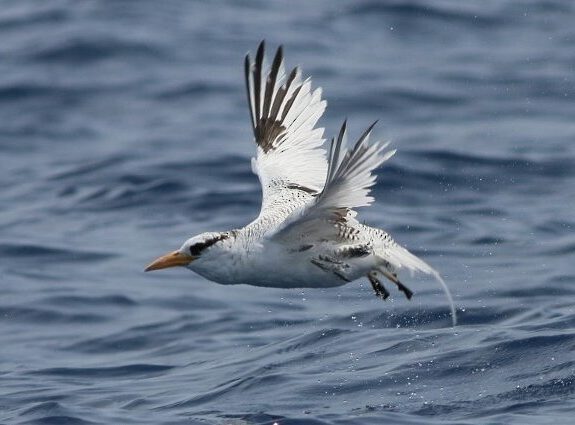
Red-billed Tropicbird, subadult showing thin, unmarked, orangish-yellow bill. (Offshore from Hatteras, North Carolina; June 1, 2017.) © Skip Russell

Arabian Tropicbird, immature showing thick, horn-colored, black-edged bill and strong carpal bar. (Offshore from Vasco da Gama, South Goa, India; November 5, 2017.) © Manjusha Savant
Immatures: Immature Red-billed and Arabian Tropicbirds are much more similar than the adults, and may be indistinguishable in many cases. The most reliable distinction appears to be bill color and pattern. Immature Arabian’s bill is horn-colored (sometimes pinkish) with distinct blackish edges, whereas Red-billed’s generally appears yellowish and has less distinct blackish edges. As they age their bills tend to brighten differently, with Arabian’s turning rosy-orange and Red-billed’s turning yellowish-orange.
They also show a weaker version of the adults’ plumage differences: immature Red-billed has a bolder black eyestripe, whereas immature Arabian has bolder black markings on the wings.
Notes
Monotypic species. Traditionally considered a subspecies of Red-billed Tropicbird (Phaethon aethereus), but the differences between these forms are striking, and appear facially sufficient to regard them as separate species.
References
BirdLife International. 2019. Phaethon aethereus. The IUCN Red List of Threatened Species 2019: e.T22696637A155736224. https://dx.doi.org/10.2305/IUCN.UK.2019-3.RLTS.T22696637A155736224.en. (Accessed August 19, 2020.)
eBird. 2020. eBird: An online database of bird distribution and abundance. Cornell Lab of Ornithology, Ithaca, N.Y. http://www.ebird.org. (Accessed August 19, 2020.)
Harrison, P. 1983. Seabirds: An Identification Guide. Houghton Mifflin, Boston.
Howell, S.N.G., and K. Zufelt. 2019. Oceanic Birds of the World. Princeton University Press.
Xeno-Canto. 2020. Red-billed Tropicbird – Phaethon aethereus. https://www.xeno-canto.org/species/Phaethon-aethereus. (Accessed August 19, 2020.)
